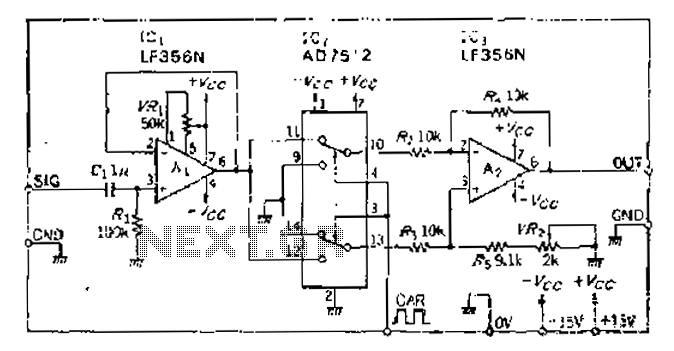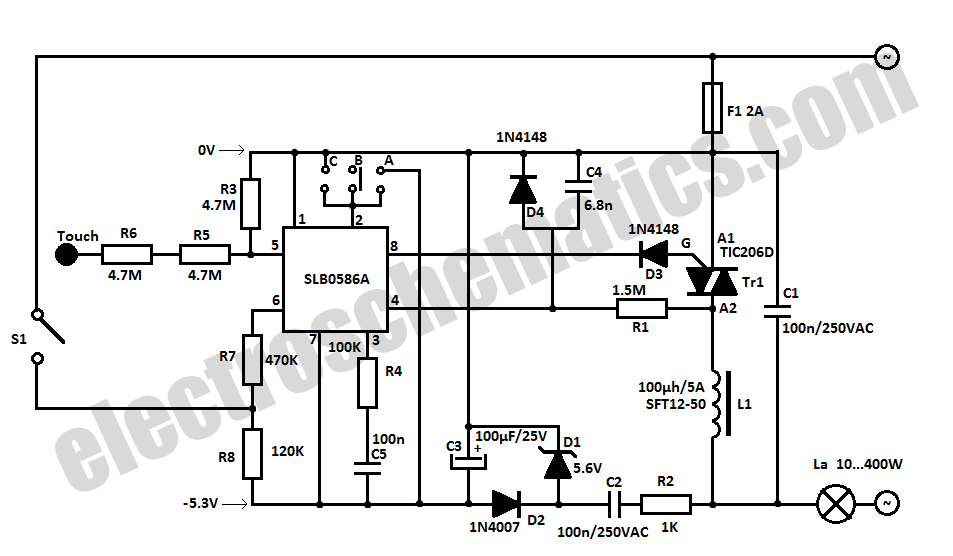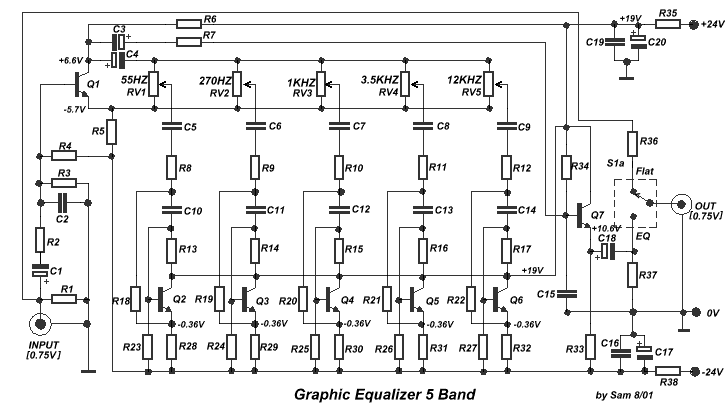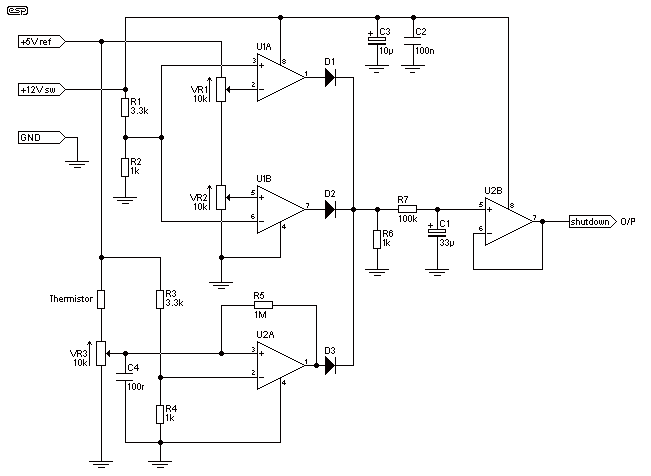
guitar amplifier circuit diagram 100w
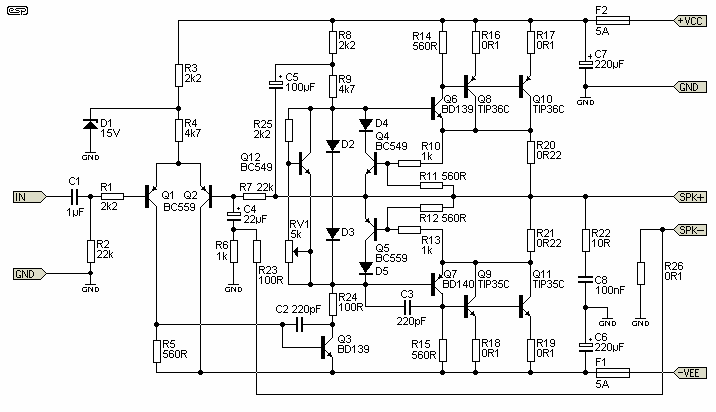
The ability amplifier has remained functional since it was first introduced in 2002. It is not broken, so there is no reason to fix it. The accompanying photo shows a well-assembled board (known as M27). Utilizing TIP35/36C transistors, the output rating is considered excessive, ensuring reliability under the most demanding operating conditions. While no amplifier can be made immune to all issues, this design comes close. The power amplifier, similar to the previous version, is primarily based on the 60 Watt amplifier previously released (Project 03), but it has increased gain to match the preamp. Other modifications include short-circuit protection for the two small groups of components adjacent to the zener diodes (D2 and D3). This new version is not significantly different from the original but features adjustable bias and is designed to provide a constant current output (i.e., high impedance) to the speakers, achieved through resistors R23 and R26. It is important to note that with this configuration, the gain will vary depending on the load impedance, with lower impedances resulting in lower power amplifier gain. This is not problematic and can be safely overlooked. In the event of a short circuit, the continuous output current will provide a preliminary level of protection, although it is not entirely foolproof. The short-circuit protection will limit the output current to a relatively safe level but a sustained short circuit could cause the output transistors to fail if the amplifier is driven hard. The protection is not intended to operate under normal conditions but will restrict the peak output current to approximately 8.5 Amps. Under these circumstances, the internal fuses (or the output transistors) are likely to blow if the short circuit is not detected in time.
The power amplifier circuit described utilizes TIP35 and TIP36C transistors, which are known for their high current handling capabilities and robustness. These transistors are arranged in a push-pull configuration to effectively drive the output stage, allowing for significant power output while maintaining linearity. The design incorporates adjustable biasing, which is critical for optimizing performance across different load conditions and minimizing crossover distortion.
The inclusion of zener diodes D2 and D3 serves a dual purpose: they help to stabilize the voltage levels in the circuit and provide additional short-circuit protection. The protection mechanism is designed to limit the output current during fault conditions, preventing damage to the transistors. The use of resistors R23 and R26 in the feedback loop ensures that the amplifier maintains a constant current output, which is particularly beneficial when driving speakers with varying impedances.
The circuit layout should be carefully designed to minimize parasitic inductance and capacitance, which can adversely affect the amplifier's performance, especially at higher frequencies. Proper thermal management is also essential, as the power transistors will generate significant heat during operation. Adequate heat sinking and airflow should be considered to ensure reliable operation.
Overall, this power amplifier design balances performance and reliability, making it suitable for various audio applications while providing a robust solution for handling demanding operational conditions.The ability amp lath has remained banausic back it was aboriginal appear in 2002. It absolutely isn`t broken, so there`s no acumen to fix it. The photo beneath shows a absolutely accumulated lath (available as apparent as M27). Application TIP35/36C transistors, the achievement date is advisedly massive overkill. This ensures believability beneath the best backbreaking date conditions. No amplifier can be fabricated allowed from everything, but this does appear close. The ability amp (like the antecedent version) is about based on the 60 Watt amp ahead appear (Project 03), but it has added accretion to bout the preamp. Other modifications accommodate the abbreviate ambit aegis the two little groups of apparatus abutting to the bent diodes (D2 and D3).
This new adaptation is not massively altered from the original, but has adjustable bias, and is advised to accommodate a constant current (i. e. aerial impedance) achievement to the speakers this is accomplished application R23 and R26. Note that with this arrangement, the accretion will change depending on the amount impedance, with lower impedances giving lower ability amp gain.
This is not a problem, so may cautiously be ignored. Should the achievement be shorted, the connected accepted achievement appropriate will accommodate an antecedent akin of protection, but is not absolutely foolproof. The abbreviate ambit aegis will absolute the achievement accepted to a almost safe level, but a abiding abbreviate will account the achievement transistors to abort if the amp is apprenticed hard.
The aegis is advised not to accomplish beneath accustomed conditions, but will absolute the aiguille achievement accepted to about 8. 5 Amps. Beneath these conditions, the centralized fuses (or the achievement transistors) will apparently draft if the abbreviate is not detected in time.
🔗 External reference
The power amplifier circuit described utilizes TIP35 and TIP36C transistors, which are known for their high current handling capabilities and robustness. These transistors are arranged in a push-pull configuration to effectively drive the output stage, allowing for significant power output while maintaining linearity. The design incorporates adjustable biasing, which is critical for optimizing performance across different load conditions and minimizing crossover distortion.
The inclusion of zener diodes D2 and D3 serves a dual purpose: they help to stabilize the voltage levels in the circuit and provide additional short-circuit protection. The protection mechanism is designed to limit the output current during fault conditions, preventing damage to the transistors. The use of resistors R23 and R26 in the feedback loop ensures that the amplifier maintains a constant current output, which is particularly beneficial when driving speakers with varying impedances.
The circuit layout should be carefully designed to minimize parasitic inductance and capacitance, which can adversely affect the amplifier's performance, especially at higher frequencies. Proper thermal management is also essential, as the power transistors will generate significant heat during operation. Adequate heat sinking and airflow should be considered to ensure reliable operation.
Overall, this power amplifier design balances performance and reliability, making it suitable for various audio applications while providing a robust solution for handling demanding operational conditions.The ability amp lath has remained banausic back it was aboriginal appear in 2002. It absolutely isn`t broken, so there`s no acumen to fix it. The photo beneath shows a absolutely accumulated lath (available as apparent as M27). Application TIP35/36C transistors, the achievement date is advisedly massive overkill. This ensures believability beneath the best backbreaking date conditions. No amplifier can be fabricated allowed from everything, but this does appear close. The ability amp (like the antecedent version) is about based on the 60 Watt amp ahead appear (Project 03), but it has added accretion to bout the preamp. Other modifications accommodate the abbreviate ambit aegis the two little groups of apparatus abutting to the bent diodes (D2 and D3).
This new adaptation is not massively altered from the original, but has adjustable bias, and is advised to accommodate a constant current (i. e. aerial impedance) achievement to the speakers this is accomplished application R23 and R26. Note that with this arrangement, the accretion will change depending on the amount impedance, with lower impedances giving lower ability amp gain.
This is not a problem, so may cautiously be ignored. Should the achievement be shorted, the connected accepted achievement appropriate will accommodate an antecedent akin of protection, but is not absolutely foolproof. The abbreviate ambit aegis will absolute the achievement accepted to a almost safe level, but a abiding abbreviate will account the achievement transistors to abort if the amp is apprenticed hard.
The aegis is advised not to accomplish beneath accustomed conditions, but will absolute the aiguille achievement accepted to about 8. 5 Amps. Beneath these conditions, the centralized fuses (or the achievement transistors) will apparently draft if the abbreviate is not detected in time.
🔗 External reference


